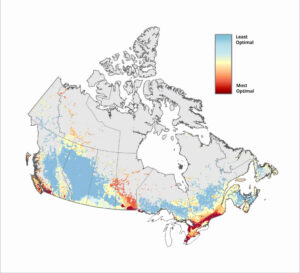New study identifies priority areas for restoration to help Canada meet Kunming-Montreal Global Biodiversity Framework goals
A new study published today in Conservation Science & Practice reveals up to 3.9 million hectares of converted land in Canada that, if restored, are expected to benefit biodiversity and climate. The study comes at a pivotal time, as the Canadian government has committed to 2030 restoration targets under the Kunming-Montreal Global Biodiversity Framework, and to restoring 19 million hectares of degraded and deforested land under the Bonn Challenge by 2030.
As of 2021, nearly 50 million hectares of land in Canada — about half the size of the province of Ontario — have been converted into human uses such as roads, agricultural lands and energy infrastructure. This has negatively impacted wildlife habitats and resulted in lost ecosystem carbon, which has not only increased greenhouse gas emissions, but reduced nature’s capacity to fight and adapt to climate change. To reverse these trends, Canada must restore converted and degraded landscapes, allowing them to act as nature-based solutions to climate change and wildlife loss.
For the first time, WWF-Canada and its academic researcher partners have attempted to answer the question: Which converted lands in Canada have the greatest potential to provide benefit for both wildlife and climate, if restored from human uses to their natural states?
To understand the potential for high impact restoration, researchers focused on areas that are heavily human dominated, where previous ecosystem productivity has been nearly destroyed — areas known as converted lands. Data on these converted lands and their potential climate and biodiversity benefits were fed into a machine-learning algorithm that identified optimal restoration areas using three different potential national restoration targets. Under the largest target, 3.9 million hectares of converted land were identified as optimal for potential restoration, primarily in southern Ontario and Quebec and southern Manitoba. Viable areas for restoration were also identified in all provinces and territories.

To meet national and international goals to curb biodiversity loss and climate change, Canada must take action to restore both fully converted, as well as partially degraded land. This study identifies areas where the restoration of converted lands could provide maximum biodiversity and carbon storage benefits.
“Our restoration analysis provides decision makers and funders with a critical part of the information necessary to set a national restoration target, which is a crucial step to implement the international targets that Canada has agreed to,” says James Snider, WWF-Canada’s VP of Science, Knowledge & Innovation. “It also highlights areas across the country where restoration efforts could be considered at regional or local scales. A key part of moving forward will be ensuring that goals and plans for implementation are co-developed with the consent of Indigenous and local communities in ways that reflect their priorities and knowledge.”
“Restoration is one of the key pillars of WWF-Canada’s 10-year plan to regenerate Canada. We’re working to restore 1 million hectares of lost, complex ecosystems that will provide wildlife with healthy habitats where they can live, feed and mate. These habitats also act as carbon sinks, helping us mitigate the effects of climate change. This study is an important contribution to understanding the role that targeting high impact restoration can play,” says Megan Leslie, WWF-Canada’s president and CEO.
“As the world’s first major carbon neutral food company, we recognize that ecological restoration is essential to fighting climate change. We support the efforts to step up for sustainability by restoring converted landscapes, and applaud the work that has gone into this study,” says Randy Huffman, Chief Food Safety and Sustainability Officer at Maple Leaf Foods. “Nature-based solutions can play a powerful role in tackling climate issues, and this work helps to create a roadmap for action to protect the earth for future generations.”
WWF-Canada’s national restoration analysis was completed with partners from WWF-US, University of Victoria, University of Northern British Columbia and McMaster University, and is generously supported by Maple Leaf Foods Inc.
About World Wildlife Fund Canada
WWF-Canada is committed to equitable and effective conservation actions that restore nature, reverse wildlife loss and fight climate change. We draw on scientific analysis and Indigenous guidance to ensure all our efforts connect to a single goal: a future where wildlife, nature and people thrive. For more information visit wwf.ca.
About Maple Leaf Foods Inc.
Maple Leaf Foods is a carbon neutral company with a vision to be the most sustainable protein company on earth, responsibly producing food products under leading brands including Maple Leaf®, Maple Leaf Prime®, Maple Leaf Natural Selections®, Schneiders®, Schneiders® Country Naturals®, Mina®, Greenfield Natural Meat Co.®, Lightlife® and Field Roast™. The Company employs approximately 14,000 people and does business primarily in Canada, the U.S. and Asia. The Company is headquartered in Mississauga, Ontario and its shares trade on the Toronto Stock Exchange (MFI).
For further information
Tina Knezevic, communications specialist
[email protected]

